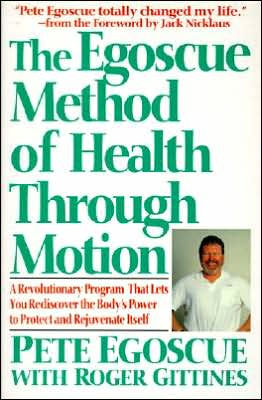No one is immune. For people from champion athletes to desk-bound white-collar professionals, many simple acts of life—a relaxing evening stroll through the neighborhood, an exhilarating run along a sandy beach, just bending down to tie a loose shoelace-are often acts of torture. The walking wounded suffer from torn rotator cuffs, tennis elbow, jogger's knees, bad backs, stiff necks, sore feet, and swollen ankles. It could, without exaggeration, be called a modem epidemic.
In this brilliant book, renowned anatomical functionalist Pete Egoscue identifies the epidemic's causes and effects. By recognizing that the human body is dependent on adequate motion to maintain its full range of physical functions, he has revolutionized both the treatment of musculoskeletal pain and the techniques for training athletes to achieve peak performance levels.
Brimming with common sense and practical advice, the heart of this important book consists of twenty-two easy-to-do, highly effective exercises that stretch, strengthen, and relax the body, allowing a return to proper alignment.
No one is immune. For people from champion athletes to desk-bound white-collar professionals, many simple acts of life—a relaxing evening stroll through the neighborhood, an exhilarating run along a sandy beach, just bending down to tie a loose shoelace-are often acts of torture. The walking wounded suffer from torn rotator cuffs, tennis elbow, jogger's knees, bad backs, stiff necks, sore feet, and swollen ankles. It could, without exaggeration, be called a modem epidemic.
In this brilliant book, renowned anatomical functionalist Pete Egoscue identifies the epidemic's causes and effects. By recognizing that the human body is dependent on adequate motion to maintain its full range of physical functions, he has revolutionized both the treatment of musculoskeletal pain and the techniques for training athletes to achieve peak performance levels.
Brimming with common sense and practical advice, the heart of this important book consists of twenty-two easy-to-do, highly effective exercises that stretch, strengthen, and relax the body, allowing a return to proper alignment.

Egoscue Method of Health Through Motion: Revolutionary Program That Lets You Rediscover the Body's Power to Rejuvenate It
224
Egoscue Method of Health Through Motion: Revolutionary Program That Lets You Rediscover the Body's Power to Rejuvenate It
224Paperback(Reprint)

Product Details
| ISBN-13: | 9780060924300 |
|---|---|
| Publisher: | HarperCollins Publishers |
| Publication date: | 08/28/1993 |
| Edition description: | Reprint |
| Pages: | 224 |
| Sales rank: | 82,322 |
| Product dimensions: | 5.31(w) x 8.00(h) x 0.50(d) |
About the Author
Customer Reviews
Explore More Items
Relive the sensuality, the romance, and the drama of Fifty Shades Freed—the love story that enthralled millions of readers around the world—through the thoughts, reflections, and dreams of
E L James revisits the world of Fifty Shades with a deeper and darker take on the love story that has enthralled millions of readers around the globe.
Their scorching, sensual affair ended in
Daunted by the singular tastes and dark secrets of the beautiful, tormented young entrepreneur Christian Grey, Anastasia Steele has broken off their relationship to start a new career with a Seattle
Look for E L James’ passionate new
DRAMA DE CINCUENTA SOMBRAS LIBERADAS
A TRAVÉS DE LOS PENSAMIENTOS Y SUEÑOS
DE CHRISTIAN GREY.
E. L. James regresa, con una mirada más
Controla cómo disfrutas tu día a día y transforma tu hogar en un refugio de calma con esta bella
Marie Kondo te ayudará a poner en orden tu casa de una vez por todas con su método inspirador paso a paso. La clave es hacer frente a tu casa en el orden correcto, para mantener
De la autora número 1 en ventas de The New York Times y gurú internacional del orden, llega La magia del orden. La novela, una divertida historia gráfica sobre Chiaki, una mujer
Recent cutting-edge research shows that human intestinal microbiota influence metabolism, appetite, energy,
A clinical reference manual for the evaluation and treatment of muscle pain
• Contains detailed illustrations of pain patterns and trigger-point locations
Myofascial pain syndromes are among
Introducing the fitness program designed by a physical therapist exclusively for women — proven to increase strength, tone muscles and reduce aches and pains in just 15 minutes a day!
Few women
